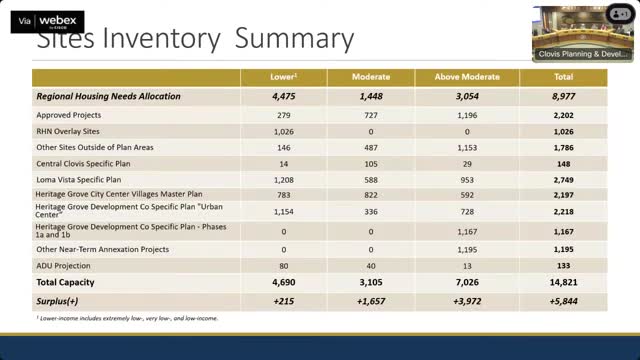City launches ambitious housing plan to boost production
October 04, 2024 | Clovis, Fresno County, California
This article was created by AI summarizing key points discussed. AI makes mistakes, so for full details and context, please refer to the video of the full meeting. Please report any errors so we can fix them. Report an error »

In a recent government meeting, city officials discussed the proactive measures taken to enhance housing availability during the current housing element cycle. The conversation highlighted the conservative estimates of housing capacities, indicating that the actual potential for development is significantly higher than reported.
The housing plan, outlined in Chapter 2 of the housing element, is structured around three primary goals: accelerating housing production, preserving and improving existing housing stock, and affirmatively furthering fair housing. To achieve these objectives, the plan includes 25 policies and 24 implementation programs.
Under the first goal of accelerating housing production, 12 implementation programs were identified, with several stemming from a recent settlement agreement. Key components of these programs include the \"no net loss\" provisions mandated by state law, which require ongoing monitoring of development activities to ensure that the city maintains adequate housing capacity throughout the planning period. This entails a rigorous tracking system to compare development progress against the Regional Housing Needs Allocation (RHNA) and ensure that sufficient capacity is available across all income levels for the next eight years.
City planning staff face significant pressure to keep detailed records and may need to rezone or identify new sites if housing capacity falls short. This ongoing commitment to monitoring and adjusting housing strategies underscores the city's dedication to meeting its housing goals and addressing community needs effectively.
The housing plan, outlined in Chapter 2 of the housing element, is structured around three primary goals: accelerating housing production, preserving and improving existing housing stock, and affirmatively furthering fair housing. To achieve these objectives, the plan includes 25 policies and 24 implementation programs.
Under the first goal of accelerating housing production, 12 implementation programs were identified, with several stemming from a recent settlement agreement. Key components of these programs include the \"no net loss\" provisions mandated by state law, which require ongoing monitoring of development activities to ensure that the city maintains adequate housing capacity throughout the planning period. This entails a rigorous tracking system to compare development progress against the Regional Housing Needs Allocation (RHNA) and ensure that sufficient capacity is available across all income levels for the next eight years.
City planning staff face significant pressure to keep detailed records and may need to rezone or identify new sites if housing capacity falls short. This ongoing commitment to monitoring and adjusting housing strategies underscores the city's dedication to meeting its housing goals and addressing community needs effectively.
View full meeting
This article is based on a recent meeting—watch the full video and explore the complete transcript for deeper insights into the discussion.
View full meeting
